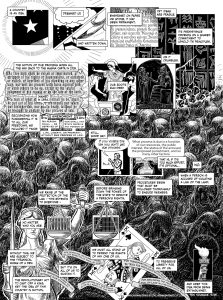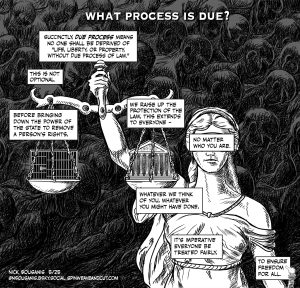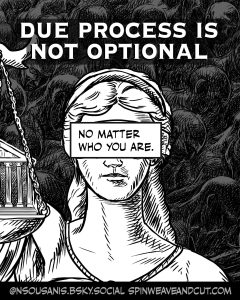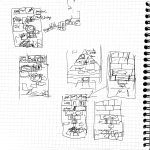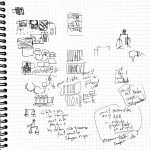I made a new comic about the origins of due process, how fundamental it is to our rights and the very notion of freedom in this country, and how we all must fight to ensure due process for everyone.
You can download a PDF for printing or sharing here. Appreciate any sharing, posting, printing to stick up on telephone polls, sending to your local representatives, whatever – thank you. (I’ve also put a hi-res file here if you’d like to print larger/poster size as some have requested – be my guest: Printable Large Due Process PDF)
Complete Alt-text is down below. And some of my notes and links I drew on as I figured this out, immediately below. With Courage – Nick
UPDATE 6/6/25: I remixed and made two small pieces from it – one very specifically on what Due Process is and the other on discarding Kings. PDF of L.Justice here & No Kings here (learn about NoKings protests here). (Hi-Res L.Justice PDF, NoKings PDF). And a bonus, super short “No Matter who you are.” (PDF here). Alt-text for each down below alt-text for the full page. Oh – I added one more “DISCARD” PDF for that here.- N
Update 6/16/25: The pieces got used as signs all over for #NoKings protests on June 14! Glad to see this in action. Included in a roundup on the Comics Beat here.
Process Notes: I made this pretty quickly for me – a few weeks of musing, note taking, sketching, then refining. The snaking movement happened early, I wasn’t satisfied with the juxtapositions doing things row-by-row. I shared this zithering sketch with my wife, who thought a gradation of light to dark made sense as background (it was blank at that point). This got me thinking of all the horrifying images I’d been looking at of CECOT and how I thought I’d reference a bit of them, but they could instead be the background that this discussion takes place over. I also was struck by how much the dehumanized figures I created for Unflattening felt like they were made real with these awful images of El Salvadoran prisoners packed together. The light in the bottom right was originally going to be the Old North Church (I actually think that was in my sketches prior to Lady Justice showing up). But as I got close to finishing it, I thought too few people would understand the reference and the light was the key thing. The Statue of Liberty is of course more obvious, and I hope makes the same point. Heather Cox Richardson writes on the significance of the Old North Church here.) I’ve drawn the Code of Hammurabi before in Unflattening and there’s a passage in my 2020 political comic “Ing” that refers to democracy not being handed down to us, rather dreamed up. And continues to say, like those who wrote it into existence, we author its future.” Also, on a comics note, the hand coming from the caption in the Magna Carta is an homage to artist Carmine Infantino who did this technique a lot, and relates to medieval examples of “Manicules.” I hand lettered the Magna Carta text over a font I found that was cool, but too unreadable, so hopefully this works. You can see all my other political comics here, which includes the recent piece Draw the Line.
And because I planned to share all my process sketches for this with my class and I’m always interested in such things myself, I created a PDF slide show here for those interested in behind the scenes stuff. Tnx for reading. – N
NOTES – things I came across, looked up for reference, as I was thinking of this piece:
- Interview with Joanne Freeman on The Bill of Rights Public Notice
- on Kilmar Abrego Garcia’s deportation – the Inquirer
- Due Process and Abrego Garcia Case: “They understand the most important fact in America right now: that if Abrego Garcia is not free, then none of us are free.” The Reason
- on Ancient Greek voting
- Conservative Judge issues dire warning about Abrego Garcia Case – Mother Jones
- Federal Appeals Court Rebuke of Trump administration – NYTimes Deputy Assistant to the President and “Counterterrorism Czar” Sebastian Gorka says anyone advocating for due process for Kilmar Abrego Garcia could be viewed as “aiding and abetting a terrorist” and be federally charged.
- US Disappeared Tracker/Mapping – Tableau
- Immigrant Rights – NYTimes Newsletter
- Due Process and State Terror – Timothy Snyder Substack
JD Vance tweet in Rolling Stone:
Vance wrote: “To say the administration must observe ‘due process’ is to beg the question: what process is due is a function of our resources, the public interest, the status of the accused, the proposed punishment, and so many other factors. To put it in concrete terms, imposing the death penalty on an American citizen requires more legal process than deporting an illegal alien to their country of origin.”
Consider that Joe Biden allowed approximately 20 million illegal aliens into our country. This placed extraordinary burdens on our country–our schools, hospitals, housing, and other essential services were overwhelmed. On top of that, many of these illegal aliens committed violent crimes, or facilitated fentanyl and sex trafficking. That is the situation we inherited.
The American people elected the Trump administration to solve this problem. The President has successfully stopped the inflow of illegal aliens, and now we must deport the people who came here illegally.
To say the administration must observe “due process” is to beg the question: what process is due is a function of our resources, the public interest, the status of the accused, the proposed punishment, and so many other factors. To put it in concrete terms, imposing the death penalty on an American citizen requires more legal process than deporting an illegal alien to their country of origin.
When the media and the far left obsess over an MS-13 gang member and demand that he be returned to the United States for a *third* deportation hearing, what they’re really saying is they want the vast majority of illegal aliens to stay here permanently.
Here’s a useful test: ask the people weeping over the lack of due process what precisely they propose for dealing with Biden’s millions and millions of illegals. And with reasonable resource and administrative judge constraints, does their solution allow us to deport at least a few million people per year?
If the answer is no, they’ve given their game away. They don’t want border security. They don’t want us to deport the people who’ve come into our country illegally. They want to accomplish through fake legal process what they failed to accomplish politically:
The ratification of Biden’s illegal migrant invasion.
President Trump and I will not stand fori t.
- Supreme Court Ruling on Abrego Garcia – Elie Mystal The Nation
- On Due process, wikipedia, Brittanica, wiktionary, due process/government overreach the Fire
- Original meaning of due process – Virginia Law Review, due process Cornell,
- Magna Carta – Library of Congress
- Judge Orders return of Garcia from El Salvador – Politico
- Trump administration argues against bringing Abrego Garcia home AP News
- Article on Abrego Garcia CNN
- Judge Orders Return of Wrongly Deported Man Reuters
- Administrative Error Sends Man To El Salvadoran prison Baltimore Sun
- Trump Admin says it can deport people for their beliefs AP News
- Indiana congresswoman says, “You violated the law, you don’t get due process.” These are the same lawmakers who oppose Red Flag Laws because they don’t provide armed domestic abusers with … due process. Twitter
- AG Pam Bondi Says Mistakenly Deported Man Should Stay Where He Is AP News
- Trump Administration to Spend $45 Billion to expand immigration Detention services NYTimes
- Photojournalist Witness arrival of Venezuelan migrants in El Salvador 60 Minutes
- Abrego Garcia US Court Document Same
- Trump Deportation Mistake New Republic
- Supreme Court Restringing order on Trump Administration Document
- Fired Milwaukee Cop’s report helped send Gay stylist to El Salvador Milwaukee Journal Sentinel
- Neighbors protect immigrant neighbor from Ice Deportation Upstate NY – The Handbasket
- Administration deports Gay Makeup Artist to El Salvador – 60 Minutes
- Russian Harvard Scientist detained NYTimes article
- Ice Director wanting to create an Amazon prime for humans – the Guardian
- Sherrilyn Ifill Americans Must prepare to fight for Rights of US Prisoners
Students
- UCLA Student Visas revoked by US Government ABC & in LA Times
- UM student visas revoked Detroit Free Press
- Harvard Student visas revoked Boston.com
- Foreign Students Pushed out of US without Reason or Process the Economic Times
- International Students Purged Chronicle of Higher Education
- Mahmoud Khalil’s Letter to Columbia from Jail Mondoeiss
Comic Alt-text
A comics page in black and white consisting of a series of panels that start in upper left, move right to edge of page, then snake back left, then right, left, and finally the bottom of the page moves left to right. Behind this meandering movement of panels and captions, is a larger image – at top left all light and at the bottom right black, and in this blackness faceless prisoners are depicted, seated, packed tightly together, bodies merging into a sea of heads, with each figure’s head another’s back.
First panel, upper left corner. Closeup on a star on the American flag. Text: “A country is an idea.” Behind the panel – halos of lines radiate outward as if this is a shining star.
Panel two and three make a rectangle, but split in two along a diagonal running from lower left of panel to upper right. In Panel 2, thought balloons on black background and 3, fingertips holding a quill pen, writing in ink the WE in the U.S. Constitution. Text: “Dreamed up, and written down.”
Panel four, words from the Constitution, lit as if by a spotlight casting an elliptical shadow. Text: “Enshrined on paper or stone, it may seem permanent,” “yet ideas are fragile.”
Panel 5 is set behind panels 4 and 6, all black and is a redrawing of a closeup of the symbols on the Code of Hammurabi. Text: “Its persistence depends on a shared commitment to uphold its principles,”
Panel 7, the image of Hammurabi from the top of the stella. Text: “or it crumbles.”
Panel 8 floats above the left edge of P7, obscuring it slightly, and here we are moving left and slightly lower with each panel. It’s a redrawing of a picture from Ancient Greece of citizens voting with Athena overseeing, overlaid on it are two inset panels showing the ceramic pieces they used for voting. Text: “Our roots run deep.”
The next panels are purely text and stretch from edge of previous panel to left edge of page, both show the part of the text in the Magna Carta of 1215 and a later iteration from 1354 addressing Due Process. “The notion of due process goes all the way back to the Magna Carta in 1215.” “(Named in 1354.)”
Captions move the eye rightward now, and again an all-text panel with both the text of the 5th and 14th amendments and their near complete overlap. Text: “Recognizing how fundamental it is to all our freedoms, we included it twice:” And then text from 5th and 14th amendments respectively “no person shall … be deprived of” “Nor shall any state deprive any person of” and the two text boxes come together to finish the phrase “life, liberty, or property, without due process of law.”
Moving further right and middle of the page, two small panels. In the first, state rep speaking into a mic, the other shows thumbs typing a tweet on a phone.
Text caption: “Still some say:” Word balloon for the state rep: “if you violate the law you don’t get due process.”
Text/tweet bubble: “What process is due is a function of our resources, the public interest, the status of the accused, the proposed punishment, and so many other factors.”
Text Caption: “That is, if it’s too much effort, it’s optional.”
Standalone caption: “NO.” This ends the rightward reading movement, and we begin one more swing back to the left, guided by the flow of captions that also are slightly lower than the next in succession. Text: “When a person is accused of violating a law of the land,” caption further left and slightly below: “procedures begin that must be followed thoroughly to ensure fairness.”
Now we see the scales of justice, held by Lady Justice who is shown roughly waist up, beginning from lower right of page. Her left arm holds the scales and reaches towards the center of the page (near where the two small panels were). Reading right to left, we first encounter a prison cell sitting in one of the scales, and in the other scale (closest to her face) a courthouse. The accompanying captions corresponding to the two scales respectively read: “Before bringing down the power of the state to remove a person’s rights,” “We raise up the protection of the law – this extends to everyone – ”
The sentence finishes with a caption centered right over justice’s blindfolded eyes: “No matter who you are.” Below this and touching the left margin of the page, caption: “Without this, we are subject to the tyrannical whims of a few.”
Now all the imagery and captions move rightward along the bottom portion of the page, though the captions rise a bit and then drift back down before the final one in the lower right corner.
First caption here: “The revolutionary act to cast off a kind, set the idea of this country in motion,” and “but it’s on all of us to sustain it.”
Floating over Lady Justice and parts of the bottom of the page are excerpts from the Declaration of Independence, written on little slivers of scroll – like fortune cookie strips. Each of these phrases refers specifically to the injustices imposed by the King (and connect to this current moment – references to Tariffs, to transporting us overseas…)
A drawing of a King ace of spaces playing card acts as panel, upright but tilted a bit. The upside down king is drawn in the style of traditional playing cards, but with the features of King George III, and the upper portion resembles Trump.
Caption over part of the card: “We must all stand up to defend the rights of any one of us,”
And other side of the card: “to preserve liberty for all of us,”
The final panel, a closeup shot of the statue of liberty’s hand and torch – its flames reaching out of the top of the panel, encircled by a faint halo of light, mirroring the light from the star in the upper left, here over the almost solid blackness of the imprisoned figures that make up the background image. Caption below: “and keep this idea from being extinguished.”
Nick Sousanis, May 2025 www.spinweaveandcut.com @nsousanis.bsky.social
Alt-Text for Due Process short:
A small comics panel – foreground lady justice holding the scales in one a prison cell in the other a court house. In the background, all dark, human figures, faceless prisoners, seated, packed tightly together, bodies merging into a sea of heads, with each figure’s head another’s back.
Captions running upper left to lower right.
Caption 1: “Our country was founded in discarding a king.”
Caption 2: “With tyranny once more upon us,”
Caption 3: “We must do it again.”
Strip along the bottom has #NoKings and my info: Nick Sousanis 5/25 @nsousanis.bsky.social www.spinweaveandcut.com
Alt-Text for Due Process – no matter who you are
At top in Large letters – “DISCARD.” At Bottom, #NoKings and my info: Nick Sousanis @nsousanis.bsky.social www.spinweaveandcut.com


